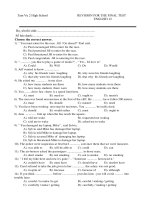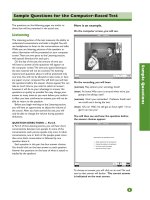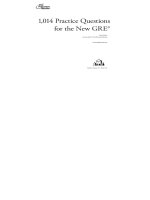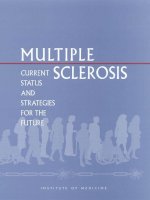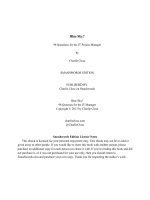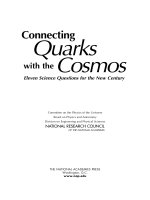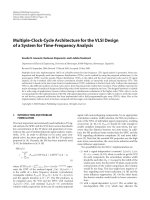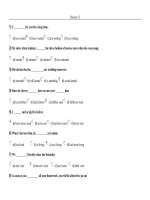2015 multiple true false questions for the final FFICM
Bạn đang xem bản rút gọn của tài liệu. Xem và tải ngay bản đầy đủ của tài liệu tại đây (2.15 MB, 350 trang )
Multiple True False Questions for
the Final FFICM
Downloaded from Cambridge Books Online by IP 216.195.11.197 on Tue Nov 03 11:14:21 GMT 2015.
/>Cambridge Books Online © Cambridge University Press, 2015
Downloaded from Cambridge Books Online by IP 216.195.11.197 on Tue Nov 03 11:14:21 GMT 2015.
/>Cambridge Books Online © Cambridge University Press, 2015
Multiple True False Questions
for the Final FFICM
Emma Bellchambers BMedSci, BMBS, MRCP, FRCA
Specialty Trainee in Anaesthesia and Intensive Care Medicine, Severn Deanery, Bristol, UK
Keith Davies MA, MBBS, FRCA, FFICM
Specialty Trainee in Anaesthesia and Intensive Care Medicine, Severn Deanery, Bristol, UK
Abigail Ford BSc (Med Sci), MBChB, MRCP, FRCA
Specialty Trainee in Anaesthesia and Intensive Care Medicine, Severn Deanery, Bristol, UK
Benjamin Walton MBChB, MRCP, FRCA, FFICM
Consultant in Critical Care and Anaesthesia, North Bristol NHS Trust, Bristol, UK
Downloaded from Cambridge Books Online by IP 216.195.11.197 on Tue Nov 03 11:14:21 GMT 2015.
/>Cambridge Books Online © Cambridge University Press, 2015
University Printing House, Cambridge CB2 8BS, United Kingdom
Cambridge University Press is part of the University of Cambridge.
It furthers the University’s mission by disseminating knowledge in the pursuit of
education, learning and research at the highest international levels of excellence.
www.cambridge.org
Information on this title: www.cambridge.org/9781107655317
© Emma Bellchambers, Keith Davies, Abigail Ford, Benjamin Walton 2015
This publication is in copyright. Subject to statutory exception
and to the provisions of relevant collective licensing agreements,
no reproduction of any part may take place without the written
permission of Cambridge University Press.
First published 2015
Printed in the United Kingdom by Clays, St Ives plc
A catalogue record for this publication is available from the British Library
Library of Congress Cataloguing in Publication data
Bellchambers, Emma, 1983– author.
Multiple true false questions for the final FFICM / Emma Bellchambers, Keith Davies,
Abigail Ford, Benjamin Walton.
p. ; cm.
Multiple true false questions for the final Faculty of Intensive Care Medicine Examination
Includes bibliographical references and index.
ISBN 978-1-107-65531-7 (pbk : alk. paper)
I. Davies, Keith (Specialty trainee in anaesthesia and intensive care medicine), author.
II. Ford, Abigail, author. III. Walton, Benjamin, author. IV. Title. V. Title: Multiple
true false questions for the final Faculty of Intensive Care Medicine Examination.
[DNLM: 1. Intensive Care – Great Britain – Examination Questions. WX 18.2]
RC86.9
616.02′ 8076 – dc23
2014020935
ISBN 978-1-107-65531-7 Paperback
Cambridge University Press has no responsibility for the persistence or accuracy of
URLs for external or third-party internet websites referred to in this publication,
and does not guarantee that any content on such websites is, or will remain,
accurate or appropriate.
.........................................................................................
Every effort has been made in preparing this book to provide accurate and up-to-date
information which is in accord with accepted standards and practice at the time of
publication. Although case histories are drawn from actual cases, every effort has been
made to disguise the identities of the individuals involved. Nevertheless, the authors,
editors and publishers can make no warranties that the information contained herein is
totally free from error, not least because clinical standards are constantly changing
through research and regulation. The authors, editors and publishers therefore disclaim
all liability for direct or consequential damages resulting from the use of material
contained in this book. Readers are strongly advised to pay careful attention to
information provided by the manufacturer of any drugs or equipment that they plan to
use.
Downloaded from Cambridge Books Online by IP 216.195.11.197 on Tue Nov 03 11:14:21 GMT 2015.
/>Cambridge Books Online © Cambridge University Press, 2015
Contents
Introduction
page vi
Exam A
1
Questions
1
Answers
21
Exam B
111
Questions
111
Answers
130
Exam C
217
Questions
217
Answers
238
Index
327
v
Downloaded from Cambridge Books Online by IP 216.195.11.197 on Tue Nov 03 11:14:41 GMT 2015.
/>Cambridge Books Online © Cambridge University Press, 2015
Cambridge Books Online
/>
Multiple True False Questions for the Final FFICM
Emma Bellchambers, Keith Davies, Abigail Ford, Benjamin Walton
Book DOI: />Online ISBN: 9781107705623
Paperback ISBN: 9781107655317
Chapter
Introduction pp. vi-vi
Chapter DOI: />Cambridge University Press
Introduction
In the United Kingdom, successful completion of the examinations for both the Primary and Final Fellowship of the Faculty of Intensive Care Medicine (FFICM) is now
an integral part of the assessment for a Certificate of Completion of Training (CCT)
in Intensive Care Medicine (ICM). Currently, a pass in the Primary examination of
one of the relevant UK medical colleges – MRCP (UK), MCEM or FRCA Primary –
allows candidates to sit the Final FFICM exam. Discussions are under way on the
introduction of a FFICM Primary examination in its own right.
The Final FFICM exam comprises three sections: a multiple choice question examination (MCQ), an objective structured oral examination (OSCE) and a structured oral
examination (SOE). From July 2014, the MCQ part of the exam has consisted of 90
questions, 60 of the multiple true false (MTF) type and 30 of the single best answer
(SBA) type. While this book will be useful for all three components of the exam, it is
best placed as a revision aid for the MTF part of the MCQ exam. The three 90-question
papers contained in the book have been designed to encompass the 13 sections that
make up the current syllabus for a CCT in ICM. This syllabus is broadly similar to the
CoBaTrICE syllabus developed under the auspices of the European Society of Intensive Care Medicine, so the questions will be of direct relevance to those candidates
undertaking this exam as well.
Each question has an answer and then both short and long explanations. The former will provide a quick revision refresher, while the long explanation gives the candidate further information on the question topic, along with one or more references
for further reading.
All exams require a certain element of luck to pass, but we believe that detailed
revision – including attempting a number of relevant MCQ questions – will improve
a candidate’s chances of success.
vi
Downloaded from Cambridge Books Online by IP 216.195.11.197 on Tue Nov 03 11:14:51 GMT 2015.
/>Cambridge Books Online © Cambridge University Press, 2015
Cambridge Books Online
/>
Multiple True False Questions for the Final FFICM
Emma Bellchambers, Keith Davies, Abigail Ford, Benjamin Walton
Book DOI: />Online ISBN: 9781107705623
Paperback ISBN: 9781107655317
Chapter
Exam A - Questions pp. 1-20
Chapter DOI: />Cambridge University Press
Exam A: Questions
Question A1
The 2012 Berlin definition of acute respiratory distress syndrome (ARDS):
A.
B.
C.
D.
E.
Requires PEEP/CPAP of 10 cmH2 O to calculate the P/F ratio
Does not require a plain chest radiograph (CXR) for diagnosis
Specifies that a diagnosis of ARDS can only be made in intubated patients
Includes a factor that corrects for altitude
Defines severe ARDS as a P/F ratio of ࣘ 100 kPa
Question A2
Regarding the timing of defibrillation during cardiopulmonary resuscitation:
A.
B.
C.
D.
E.
It should be delayed until after 2 minutes of good-quality CPR
Epinephrine should be given after the second shock for refractory VF/VT
Three shocks can be given before CPR for a witnessed, monitored arrest
A 10-second pulse check should be performed after each shock
Defibrillation should be delayed until the patient’s core temperature is > 30 °C
Question A3
With regards to the management of patients who have tricyclic antidepressant (TCA)
toxicity, which of the following are correct?
A. Cardiac function is affected late or at high plasma levels compared to other
tissues in the body
B. TCAs competitively inhibit sodium channels in the heart, leading to slowed
conduction
C. Life-threatening effects are most likely to be seen after at least 12 hours following
ingestion of high doses
D. Seizures are usually preceded by significant change in mental status or other
neurological changes
E. Increasing the plasma pH to achieve alkalosis reduces the free fraction of TCA by
up to 20%
Downloaded from Cambridge Books Online by IP 216.195.11.197 on Tue Nov 03 11:15:16 GMT 2015.
/>Cambridge Books Online © Cambridge University Press, 2015
1
Exam A: Questions
Question A4
Regarding synchronised intermittent mandatory ventilation (SIMV):
A.
B.
C.
D.
E.
Set tidal volume should be 6 ml/kg actual body weight
It may be useful for patients with raised intracranial pressure
It is a form of volume-controlled ventilation
Inspiratory flow decreases exponentially
It may lead to an increase in intrinsic positive end-expiratory pressure (iPEEP)
Question A5
The APACHE II severity of illness score includes the following variables:
A.
B.
C.
D.
E.
Age
Serum lactate
PaO2 /FiO2 ratio
Glasgow Coma Scale
PaCO2
Question A6
Regarding treatment for acute coronary syndromes (ACS):
A. Aspirin and clopidogrel should be offered to all ACS patients
B. -Blockers are contraindicated in asthma, pulmonary oedema and
atrioventricular block
C. Unfractionated heparin should be used in preference to low-molecular-weight
heparin (LMWH) in renal impairment
D. STEMI patients should be transferred for primary PCI if available within
90 minutes
E. Thrombolysis is contraindicated in patients taking warfarin
Question A7
With regards to the assessment and management of patients with acute upper gastrointestinal bleeding, which of the following are correct?
A.
B.
C.
D.
E.
The Blatchford scoring system should be used in all patients at first assessment
The full Rockall scoring system should be used following endoscopy
Proton-pump inhibitors should be commenced in all patients at presentation
Terlipressin should be commenced only once variceal bleeding is confirmed
Aspirin should not be recommenced once haemostasis is achieved
Question A8
According to the Surviving Sepsis guidelines (2012), the following supportive therapies are recommended for all patients with severe sepsis:
2
A.
B.
C.
D.
E.
Selenium
Sodium bicarbonate to improve haemodynamics in lactic acidaemia (pH ࣙ 7.15)
Glucose control between 4.5 and 6.0 mmol/l (80–110 mg/dl)
Unfractionated heparin (UFH) if creatinine clearance is < 30 ml/min
Stress ulcer prophylaxis
Downloaded from Cambridge Books Online by IP 216.195.11.197 on Tue Nov 03 11:15:16 GMT 2015.
/>Cambridge Books Online © Cambridge University Press, 2015
Exam A: Questions
Question A9
Which of the following statements concerning cardiac output (CO) monitors using
pulse contour analysis (PCA) are true?
A. They calculate SV and CO using the arterial pressure waveform, compliance and
SVR
B. They may be calibrated using indicator dilution CO measurements
C. Demographic and physical data may be used to estimate arterial compliance
D. Accuracy is largely unaffected by damping of the arterial trace
E. Choice of arterial site may affect data quality
Question A10
Regarding the investigation and management of primary and secondary spontaneous
pneumothorax (PSP and SSP):
A. Expiratory chest radiographs are preferred to inspiratory chest radiographs
B. A large pneumothorax is defined as a visible rim of air > 3 cm at the level of the
hilum
C. Patients with large pneumothoraces should be admitted to hospital
D. Patients with secondary spontaneous pneumothorax should always be admitted
to hospital
E. A large pneumothorax should be treated with an intercostal drain
Question A11
With regards to thermoregulation, which of the following are correct?
A.
B.
C.
D.
Rectal temperature is an accurate way to assess core temperature
Heat stroke can be life-threatening
Genetic factors predispose to heat stroke
Heat stroke is rare in elderly patients, as they are more susceptible to
hypothermia
E. The hypothalamus is not involved in temperature regulation in patients with
heat stroke
Question A12
In the treatment of shock:
A. Colloids are better than crystalloids for treating hypovolaemia
B. Intra-aortic balloon pumps reduce afterload and improve coronary perfusion
C. Treatment should start with fluid boluses, then vasoconstrictors, followed by
inotropes
D. Treatment should focus on restoring pre-morbid blood pressure
E. Fluid resuscitation should be guided by measures such as CVP, stroke volume
variation or central venous oxygen saturation
Question A13
Hypernatraemia:
A. Is a recognised cause of subarachnoid haemorrhage
Downloaded from Cambridge Books Online by IP 216.195.11.197 on Tue Nov 03 11:15:16 GMT 2015.
/>Cambridge Books Online © Cambridge University Press, 2015
3
Exam A: Questions
B. Should be treated with 0.9% sodium chloride if the plasma sodium is
> 160 mmol/l
C. Should be reduced by no more than 10 mmol/l/day
D. If caused by diabetes mellitus should be treated with desmopressin
E. Is caused by treatment with intravenous ciprofloxacin
Question A14
Inotropic drugs:
A.
B.
C.
D.
E.
Cause increased force of contraction of the heart
Usually increase intracellular calcium levels by increasing cAMP levels
Act on cell-surface receptors
Increase myocardial work and oxygen demand
Need to be given with a vasoconstrictor to offset vasodilatation
Question A15
With regards to parenteral nutrition, which of the following are correct?
A.
B.
C.
D.
E.
Soybean oil is commonly used as a source of essential fatty acids and lipid
Carbohydrate is usually supplied as fructose
Glutamine supplementation improves patient outcome
Protein is given as amino acid mixes and acts as an energy substrate
Trace elements such as selenium are added separately, for stability reasons
Question A16
Regarding the management of acute asthma, which of the following are correct?
A. Mortality is higher in patients with adverse psychosocial factors
B. A single dose of intravenous magnesium sulphate should be administered to
patients with life-threatening asthma
C. Intravenous aminophylline is no longer recommended for any patients
D. Heliox is recommended as a treatment for near-fatal asthma in patients who are
admitted to intensive care
E. Non-invasive ventilation has no place in the treatment of acute asthma in adults
Question A17
Regarding the causes of hypotension, which of the following are correct?
A. Anaphylaxis is accompanied by tachycardia
B. Bradycardia and hypotension are seen in neurogenic shock
C. Hypotension is commonly a late sign in hypovolaemic shock due to
haemorrhage
D. Sepsis causes tachycardia, hypotension and reduced cardiac output
E. Cardiogenic shock is accompanied by hypotension
4
Downloaded from Cambridge Books Online by IP 216.195.11.197 on Tue Nov 03 11:15:16 GMT 2015.
/>Cambridge Books Online © Cambridge University Press, 2015
Exam A: Questions
Question A18
The following are sources of inaccuracy in pulse oximetry monitoring of oxygen saturations:
A.
B.
C.
D.
E.
Arterial oxygen saturations below 70%
Movement
Cyanide poisoning
Methaemoglobinaemia
Carbon monoxide poisoning
Question A19
Concerning the causes of acute seizures:
A.
B.
C.
D.
E.
Multiple sclerosis causes acute seizures in 2% of patients with the disease
Hypernatraemia can cause seizures
Patients must have two or more seizures to be diagnosed with epilepsy
Non-epileptic seizures usually involve incontinence
Febrile convulsions lead to epilepsy in most patients
Question A20
With respect to the cleaning of medical equipment:
A. Hydrogen peroxide treatment will sterilise an object
B. Pasteurisation is the removal of all viable microorganisms and infectious agents
from an object
C. Sterilisation will effectively remove prions
D. Autoclaving an object will sterilise it
E. 2% glutaraldehyde will disinfect an object
Question A21
Regarding the anterior triangle of the neck:
A.
B.
C.
D.
E.
The common carotid artery divides at the level of the cricoid cartilage
The internal jugular vein travels in the carotid sheath lateral to the carotid artery
The vagus nerve travels posterior to the carotid sheath
The internal jugular vein is valveless
The carotid body contains baroreceptors and is found above the carotid
bifurcation
Question A22
The following are absolute indications for tracheal intubation and ventilatory
support:
A.
B.
C.
D.
E.
PaO2 < 8 kPa (60 mmHg)
PaCO2 > 8 kPa (60 mmHg)
GCS < 8
Septic shock with a severe metabolic acidosis
Ventilatory insufficiency from fractured ribs
5
Downloaded from Cambridge Books Online by IP 216.195.11.197 on Tue Nov 03 11:15:16 GMT 2015.
/>Cambridge Books Online © Cambridge University Press, 2015
Exam A: Questions
Question A23
With respect to the measurement of venous blood gases:
A. Mixed venous oxygen saturation is normally 70%
B. Central venous saturations are generally 5% lower than mixed venous oxygen
saturations
C. Mixed venous oxygen saturation is decreased by shunt in septic shock
D. Venous bicarbonate is usually 3–4 mmol/l higher in venous blood than in arterial
E. Venous pH is usually 0.03–0.05 pH units lower than arterial pH
Question A24
Chest compressions during cardiopulmonary resuscitation:
A.
B.
C.
D.
E.
Should be at a rate of 100–120/minute
Increase the likelihood of VF being successfully defibrillated
Provide a circulation to the brain and heart that is at best 25% of normal
Should be continuous if a supraglottic airway has been inserted
Should be continued while the defibrillator is charging
Question A25
Regarding the intraosseous (IO) route of drug administration, which of the following
are correct?
A. It is a good alternative to central venous access for children requiring long-term
antibiotic therapy
B. It should always be considered in the paediatric resuscitation scenario, where
obtaining intravenous access is likely to be challenging
C. The iliac crest is the preferred location for access, because of its proximity to
the skin
D. The incidence of serious complications such as skin necrosis or osteomyelitis is
around 5%
E. The speed of drug onset following administration is likely to be slower than
following intravenous administration
Question A26
Transfusion-related acute lung injury (TRALI):
A.
B.
C.
D.
E.
Is more common if blood is donated by a multiparous woman
Is most common after red cell transfusion
Is a complication of intravenous immunoglobulin therapy
Is usually seen between 12 and 24 hours after transfusion
Is associated with high pulmonary artery wedge pressures
Question A27
Ventilatory modes useful in weaning a patient from mechanical ventilation
include:
6
A. Synchronised intermittent mandatory ventilation (SIMV) with pressure support
B. Bilevel ventilation (BIPAP) with pressure support
C. Non-invasive ventilation (NIV)
Downloaded from Cambridge Books Online by IP 216.195.11.197 on Tue Nov 03 11:15:16 GMT 2015.
/>Cambridge Books Online © Cambridge University Press, 2015
Exam A: Questions
D. Airway pressure-release ventilation (APRV)
E. Pressure-support ventilation without automatic tube compensation
Question A28
Regarding the Glasgow Coma Scale (GCS):
A.
B.
C.
D.
E.
It is a three-part scoring system giving a score of 0–15
The motor score is the most useful discriminator
It should only be applied to patients with head injuries
A score of ࣘ 8 defines severe head injury and mandates intubation
It can be modified for use in children
Question A29
In the treatment of drowning victims:
A. Chest compressions should be started immediately in the presence of cardiac
arrest
B. Cervical spine injury is common in drowning victims
C. Salt-water drowning causes more severe acute respiratory distress syndrome
(ARDS) than fresh-water drowning
D. Antibiotics should be started after open-water drowning
E. Non-fatal fresh-water drowning is characterised by a dilutional hyponatraemia
Question A30
Regarding skin disinfection:
A. 0.5% chlorhexidine has a concentration below the minimal inhibitory
concentration (MIC) for most nosocomial bacteria
B. 2% chlorhexidine in 70% alcohol is recommended for skin disinfection prior to
insertion of a central venous catheter
C. Aqueous 0.5% chlorhexidine is recommended for skin disinfection prior to
insertion of an epidural catheter
D. 10% povidone–iodine has a similar efficacy to 2% chlorhexidine in preventing
catheter-related bloodstream infections (CRBSI)
E. The use of acetone to remove skin lipids prior to insertion of a central venous
catheter reduces CRBSI
Question A31
Concerning ventilator-associated pneumonia (VAP):
A.
B.
C.
D.
E.
VAP is associated with increased mortality and length of stay
VAP is defined as a pneumonia occurring after 48 hours of ventilation
Lung-protective ventilation (6 ml/kg IBW) reduces rates of VAP
Gastric ulcer prophylaxis with proton-pump inhibitors increases VAP rates
Selective decontamination of the digestive tract (SDD) reduces VAP rates
Question A32
Which of the following drug assays are routinely available to measure plasma levels?
A. Phenytoin
B. Tacrolimus
7
Downloaded from Cambridge Books Online by IP 216.195.11.197 on Tue Nov 03 11:15:16 GMT 2015.
/>Cambridge Books Online © Cambridge University Press, 2015
Exam A: Questions
C. Flecainide
D. Digoxin
E. Sodium valproate
Question A33
Which of these statements about pulmonary function tests are correct?
A.
B.
C.
D.
E.
FEV1 is normal or increased in restrictive lung disease
Gas transfer of CO measures V/Q matching
PEFR monitoring can be used to predict exacerbations of asthma
Spirometry gives values for FEV1 , FVC, FRC and tidal volume
FEV1 /FVC ratio of < 70% is consistent with an obstructive lung disease
Question A34
With regards to smoke inhalation, which of the following are correct?
A. Early bronchoscopy and washout can be helpful
B. Upper airway swelling occurs rapidly, and intubation should be performed
pre-hospital
C. Cut endotracheal tubes are preferred
D. Hoarseness is a common sign and does not signify airway compromise
E. Burns to the face, lips and eyebrows are a worrying sign
Question A35
Regarding the monitoring of cardiac output (CO):
A.
B.
C.
D.
E.
Thermodilution with a pulmonary artery (PA) catheter is the gold standard
Pulse contour analysis (PCA) requires calibration with indicator studies
CO monitors use the Fick principle to calculate CO
The ability to accurately measure CO is more important than tracking changes
Fluid responsiveness is reflected by an observed increase in stroke volume (SV)
after a fluid bolus
Question A36
With respect to mast-cell tryptase sampling after anaphylaxis:
A.
B.
C.
D.
E.
A-tryptase is measured to ascertain if a reaction is anaphylaxis
The volume of intravenous resuscitation fluid should be taken into account
The assay has a high sensitivity
Samples taken more than 12 hours post mortem are unreliable
Tryptase levels are likely to be raised by myocardial infarction
Question A37
Regarding lumbar puncture (LP):
A. Blood-stained CSF is not diagnostic of subarachnoid haemorrhage (SAH)
8
Downloaded from Cambridge Books Online by IP 216.195.11.197 on Tue Nov 03 11:15:16 GMT 2015.
/>Cambridge Books Online © Cambridge University Press, 2015
Exam A: Questions
B. Post-dural puncture headache (PDPH) is prevented by the use of a 25G
pencil-point needle
C. Absolute contraindications include coagulopathy, patient refusal and local
infection
D. LP should not be performed in patients with raised intracranial pressure
E. LP can be performed at any lumbar level
Question A38
Regarding antibiotic resistance:
A.
B.
C.
D.
E.
Free bacterial DNA is commonly found in the blood of intensive care patients
Genetic mutation is the most common mechanism of acquisition of resistance
Plasmids move independently of bacteria to spread resistance
Intrinsic resistance occurs as a result of genetic mutation
Transposons may insert DNA into either the bacterial chromosome or a plasmid
to confer resistance
Question A39
The following physiological changes contribute to stress hyperglycaemia:
A.
B.
C.
D.
E.
Increased cortisol levels
Reduced corticotrophin-releasing hormone (CRH) levels
Insulin resistance
Increased glycogenesis
Increased norepinephrine levels
Question A40
Following return of spontaneous circulation (ROSC) from out-of-hospital cardiac
arrest (OHCA), the following are useful indicators of neurological outcome:
A.
B.
C.
D.
E.
Fixed dilated pupils on admission
Isoelectric EEG
Post-arrest myoclonic status epilepticus
Absent somatosensory evoked potentials (SSEPs)
Loss of grey–white distinction on CT brain
Question A41
Appropriate immediate management of acute cardiogenic pulmonary oedema
includes:
A.
B.
C.
D.
E.
Intravenous opiates
Norepinephrine
Haemofiltration
ACE inhibitors
Intra-aortic balloon pump (IABP)
9
Downloaded from Cambridge Books Online by IP 216.195.11.197 on Tue Nov 03 11:15:16 GMT 2015.
/>Cambridge Books Online © Cambridge University Press, 2015
Exam A: Questions
Question A42
The following ECG changes are characteristic of hypokalaemia:
A.
B.
C.
D.
E.
Bradycardia more commonly than tachycardia
Delta waves
T-wave inversion
ST depression
U waves
Question A43
With respect to antifungal agents used in critical care:
A.
B.
C.
D.
E.
Echinocandins have the best side-effect profile of the antifungal agents
Fluconazole should be first line for invasive aspergillosis
Amphotericin B is fungistatic
Oral fluconazole is 100% bioavailable
Amphotericin B exhibits dose-limiting nephrotoxicity
Question A44
The following sites allow accurate measures of core temperature:
A.
B.
C.
D.
E.
Tympanic membrane
Nasopharynx
Bladder
Groin
Forehead
Question A45
Chronic obstructive pulmonary disease (COPD):
A. Is classified for severity on the basis of forced expiratory volume in 1 second
(FEV1 ) measurements
B. Requiring ICU admission confers a 50% 1-year mortality
C. Is responsible for approximately 40% of patients admitted in type 2 respiratory
failure
D. Treated with long-term oxygen therapy has improved mortality
E. Should be treated with non-invasive ventilation as a first-line therapy for PaCO2
> 6 kPa
Question A46
Regarding the differences between partial- and full-thickness burns, which of the following are correct?
10
A.
B.
C.
D.
E.
Partial-thickness burns are usually painless
Full-thickness burns are usually more extensive than partial-thickness burns
Full-thickness burns can include loss of hair follicles and nerve endings
A white and rubbery appearance indicates a full-thickness burn
Partial-thickness burns often require escharotomy
Downloaded from Cambridge Books Online by IP 216.195.11.197 on Tue Nov 03 11:15:16 GMT 2015.
/>Cambridge Books Online © Cambridge University Press, 2015
When planning extracorporeal membrane oxygenation (ECMO) treatment:
A. Patients with cardiorespiratory failure are suitable for venovenous ECMO
B. Patients should have a reversible cause or be on a transplant list
C. Venoarterial ECMO can be used as a bridging device prior to insertion of a
ventricular assist device
D. Arteriovenous ECMO is useful to increase blood oxygenation
E. Carbon dioxide clearance is more efficient than oxygenation
Exam A: Questions
Question A47
Question A48
Regarding delayed cerebral ischaemia (DCI) following subarachnoid haemorrhage
(SAH):
A.
B.
C.
D.
E.
DCI may be effectively prevented with oral nimodipine
Digital subtraction angiography (DSA) is the best investigation for vasospasm
Maintenance of euvolaemia is as effective as hypervolaemia in treating DCI
Haemodilution is only effective in patients with high haematocrits
DCI in patients with unsecured aneurysms can still be treated with hypertension
Question A49
Meropenem:
A.
B.
C.
D.
E.
Does not require dose reduction in acute kidney injury
Is a -lactam antibiotic
Is contraindicated in patients with a penicillin allergy
Is effective against methicillin-resistant Staphylococcus aureus (MRSA) infections
Is ineffective against extended-spectrum -lactamase (ESBL) Enterobacteriaceae
Question A50
Specific ECG changes are characteristically associated with certain conditions. Which
of the following associations are correct?
A.
B.
C.
D.
E.
COPD – P mitrale
Paracetamol overdose – prolonged QT interval
Hypothermia – U waves
Hyperchloraemia – widened QRS complex
High digoxin levels – concave ST elevation in chest leads
Question A51
With regards to the assessment of delirium, which of the following are correct?
A. The CAM-ICU assessment tool can be performed on patients who are intubated
B. The DSM-IV criteria can only be used by psychiatrists in the identification of
delirium
C. The Intensive Care Delirium Screening Checklist (ICDSC) requires a qualified
doctor to carry out the assessment
D. The CAM-ICU assessment tool cannot be used if a patient is sedated
E. The CAM-ICU assessment and ICDSC have been shown to have high sensitivity
in identifying patients with delirium
Downloaded from Cambridge Books Online by IP 216.195.11.197 on Tue Nov 03 11:15:16 GMT 2015.
/>Cambridge Books Online © Cambridge University Press, 2015
11
Exam A: Questions
Question A52
Causes of bacterial meningitis include:
A.
B.
C.
D.
E.
Haemophilus influenzae
Staphylococcus aureus
Listeria monocytogenes
Streptococcus pneumoniae
Staphylococcus epidermidis
Question A53
Risk factors for pulmonary embolus include:
A.
B.
C.
D.
E.
Renal replacement therapy on ICU
Lightning strike
Factor V Leiden mutation
Rheumatoid arthritis
Cardiac failure
Question A54
The following are evidence-based criteria for discontinuation of renal replacement
therapy (RRT):
A.
B.
C.
D.
E.
pH > 7.30
Serum urea < 10 mmol/l
Serum potassium < 5 mmol/l
Urine output > 450 ml/day
Serum creatinine < 200 mol/l
Question A55
Following diagnosis of brain death:
A.
B.
C.
D.
E.
Myocardial damage often occurs
There is commonly hypotension followed by hypertension
Patients are at greater risk of hypothermia
Diabetes insipidus is a common feature
Patients commonly develop an active inflammatory response and/or
disseminated intravascular coagulation (DIC)
Question A56
With regards to patients who are intoxicated with ethanol, which of the following are
correct?
12
A. Outcome following traumatic brain injury is worse if the patient is intoxicated at
time of injury compared with a similar injury in a sober patient
B. A metabolic alkalosis is the commonest acid–base derangement seen
C. Insulin and dextrose infusion is recommended in patients with alcoholic
ketoacidosis
D. Outcome following major burns is worse in intoxicated than in non-intoxicated
patients
Downloaded from Cambridge Books Online by IP 216.195.11.197 on Tue Nov 03 11:15:16 GMT 2015.
/>Cambridge Books Online © Cambridge University Press, 2015
Question A57
Stress ulcer prophylaxis in ICU:
Exam A: Questions
E. Alcoholic ketoacidosis is most commonly seen in patients with chronic alcohol
dependence
A.
B.
C.
D.
Should be given to all ventilated patients
Increases the risk of Clostridium difficile infection
Reduces ICU mortality
Leads to the side effect of interstitial nephritis more commonly with
proton-pump inhibitors (PPIs) than with histamine H2 receptor antagonists
(H2 RAs)
E. Is associated with lower rates of ventilator-associated pneumonia (VAP) when
PPIs are used, compared with H2 RAs
Question A58
With regards to the intra-aortic balloon pump (IABP) which of the following are
correct?
A.
B.
C.
D.
E.
The balloon inflates during systole to improve cardiac output
Cardiac output is improved by up to 20%
Post-acute MI ventricular septal defect is an indication for use
Aortic stenosis is a contraindication to its use
The balloon should be left in situ for 6 hours once it has been weaned off in case
of deterioration
Question A59
The following are recognised causes of rhabdomyolysis:
A.
B.
C.
D.
E.
Statins
Diabetic ketoacidosis (DKA)
Epilepsy
Isoflurane
Gentle exercise
Question A60
With regards to the assessment and management of a patient with diabetic ketoacidosis (DKA), which of the following are correct?
A. DKA most commonly occurs in patients without a previous diagnosis of diabetes
mellitus
B. Hyperglycaemia commonly causes a falsely elevated measured plasma sodium
concentration
C. The cause of DKA is often not found
D. An elevated anion gap metabolic acidosis is a key feature of DKA
E. An elevated white cell count is often seen in DKA even in the absence of infection
Downloaded from Cambridge Books Online by IP 216.195.11.197 on Tue Nov 03 11:15:16 GMT 2015.
/>Cambridge Books Online © Cambridge University Press, 2015
13
Exam A: Questions
Question A61
In the case of a general surgical patient with severe sepsis:
A.
B.
C.
D.
E.
The patient should be operated on within 6 hours unless resuscitation is required
The mortality rate is < 10%
A predicted mortality score of ࣙ 5% indicates a high-risk patient
In septic shock, a delay to surgery of > 12 hours increases mortality rates to 60%
All patients with predicted mortality ࣙ 10% should receive postoperative care on
HDU or ICU
Question A62
With regards to severe eclampsia, which of the following are correct?
A. It is the commonest reason for maternal admission to the intensive care unit
B. High-resistance uterine spiral arteries persist due to deficient placental
implantation
C. Seizures are due to ischaemia caused by cerebral vasoconstriction
D. Because of volume depletion, aggressive fluid resuscitation should be
commenced without delay
E. Phenytoin loading should be started after two seizures
Question A63
The following treatments have been shown to reduce mortality in systolic heart failure (heart failure with left ventricular ejection fraction < 40%)
A.
B.
C.
D.
E.
Loop diuretics
Mineralocorticoid receptor antagonists (MRAs)
-adrenergic receptor antagonists
Statins
Non-dihydropyridine calcium-channel blockers
Question A64
Regarding myasthenia gravis (MG):
A. MG affects central more than peripheral muscles
B. The Tensilon (edrophonium) test is the most sensitive and specific diagnostic test
for MG
C. Almost all patients have autoantibodies to postsynaptic acetylcholine receptors
D. Vital capacity (VC) < 15 ml/kg is an indication for intubation
E. Plasma exchange is the most effective treatment for myasthenic crisis
Question A65
Diagnosis of death:
14
A.
B.
C.
D.
E.
Is made by a doctor
Can be determined by somatic, cardiorespiratory or neurological criteria
Requires demonstration of the loss of consciousness and loss of cardiac output
Takes 5 minutes using cardiorespiratory criteria in the UK
Is impossible to determine neurologically in massive craniofacial injuries
Downloaded from Cambridge Books Online by IP 216.195.11.197 on Tue Nov 03 11:15:16 GMT 2015.
/>Cambridge Books Online © Cambridge University Press, 2015
Regarding acute liver failure:
A. Coagulopathy, jaundice and encephalopathy must be present to make the
diagnosis
B. It may be diagnosed if encephalopathy follows jaundice within 6 months
C. The commonest cause worldwide is paracetamol toxicity
D. Clinical examination commonly reveals signs of chronic liver disease
E. It is often caused by hepatitis B and C viruses
Exam A: Questions
Question A66
Question A67
The following structures will be traversed during a midline lumbar puncture (LP):
A.
B.
C.
D.
E.
Interspinous ligament
Pia mater
Supraspinous ligament
Arachnoid mater
Ligamentum flavum
Question A68
In a case of neutropenic sepsis:
A. It is defined as fever (> 38 °C) in a patient with neutrophil count < 1.0 × 109 /l
B. Broad-spectrum antibiotics should be started within 8 hours
C. Antibiotics should not be delayed for taking of blood and other samples for
culture
D. Empirical therapy should include antibacterial and antifungal agents
E. Tunnelled lines may be safely left in situ in neutropenic patients with
bacteraemia
Question A69
With regards to short bowel syndrome, which of the following are correct?
A. Intestinal remnant length is the primary determinant of outcome in patients with
short bowel syndrome
B. Short bowel syndrome will develop in most patients once 50% of the small
intestine is lost
C. Bile salt malabsorption is unusual in patients with large terminal ileum
resections
D. Iron deficiency is common in patients who have had significant ileal resections
E. Cholelithiasis is a common problem and has a higher incidence in patients
receiving total parenteral nutrition (TPN)
Question A70
Necrotising fasciitis:
A. Is most commonly polymicrobial
B. Is rarely caused by fungal infection
C. Spreads between the dermis and superficial fascia
Downloaded from Cambridge Books Online by IP 216.195.11.197 on Tue Nov 03 11:15:16 GMT 2015.
/>Cambridge Books Online © Cambridge University Press, 2015
15

